Application of Zeolite Tuffs as Mineral Filler in Warm Mix Asphalt
Abstract
:1. Introduction
2. Experimental Materials
3. Research Method
3.1. Characterization of Clinoptilolite and Limestone
3.2. Asphalt Mastics Properties
3.3. Determination of Samples
- 35/50—basic 35/50 asphalt,
- C—35/50 asphalt with 5% zeolite tuff (clinoptilolite),
- L—35/50 asphalt with 5% lime filler,
- H—35/50 asphalt with 5% hydrated lime,
- 0.5C + 0.5L—35/50 asphalt with 5% mixture consisting of 50% zeolite tuff and 50% lime filler,
- 0.25C + 0.75L—35/50 asphalt with 5% mixture consisting of 25% zeolite tuff and 75% lime filler,
- 0.4C + 0.4L + 0.2H—35/50 asphalt with 5% mixture consisting of 40% zeolite tuff, 40% lime filler and 20% hydrated lime.
4. Results and Discussion
4.1. Characteristics of Zeolite Tuff, Limestone and Hydrated Lime
4.1.1. Chemical Composition
4.1.2. Mineral Composition
4.1.3. Grading
4.2. Asphalt Mastics Properties
4.3. Statistical Data Analysis
5. Conclusions
Author Contributions
Funding
Conflicts of Interest
References
- Asphalt in Figures. 2016. Available online: https://eapa.org/userfiles/2/Asphalt%20in%20Figures/2016/AIF_2016.pdf (accessed on 15 August 2019).
- Asphalt Pavement Industry Survey on Recycled Materials and Warm-Mix Asphalt Usage. NAPA, 2017. Available online: http://www.asphaltpavement.org/PDFs/IS138/IS138-2017_RAP-RAS-WMA_Survey_Final.pdf (accessed on 15 August 2019).
- Diab, A.; Enieb, M. Investigating influence of mineral filler at asphalt mixture andmastic scales. Int. J. Pavement Res. Technol. 2018, 11, 213–224. [Google Scholar] [CrossRef]
- Liu, G.; Yang, T.; Li, J.; Jia, Y.; Zhao, Y.; Zhang, J. Effects of aging on rheological properties of asphalt materials and asphalt-filler interaction ability. Constr. Build. Mater. 2018, 168, 501–511. [Google Scholar] [CrossRef]
- Wen, Y.; Guo, N.; You, Z.; Wang, L.; Tan, Y. Comparative evaluation of rheological properties and micromechanics of non-foamed and foamed asphalt mastic. Constr. Build. Mater. 2018, 193, 654–664. [Google Scholar] [CrossRef]
- Nciri, N.; Shin, T.; Lee, H.; Cho, N. Potential of waste oyster shells as a novel bio filler for hot-mix asphalt. Appl. Sci. 2018, 8, 415. [Google Scholar] [CrossRef] [Green Version]
- Pasandín, A.R.; Pérez, I. The influence of the mineral filler on the adhesion between aggregates and bitumen. Int. J. Adhes. Adhes. 2015, 58, 53–58. [Google Scholar] [CrossRef] [Green Version]
- Cheng, Y.; Tao, J.; Jiao, Y.; Tan, G.; Guo, Q.; Wang, S.; Ni, P. Influence of the properties of filler on high and medium temperature performances of asphalt mastic. Constr. Build. Mater. 2016, 118, 268–275. [Google Scholar] [CrossRef]
- Li, R.; Du, H.; Fan, Z.P.; Pei, J.Z. Molecular dynamics simulation to investigate the interaction of asphaltene and oxide in aggregate. Adv. Mater. Sci. Eng. 2016, 7, 1–10. [Google Scholar] [CrossRef] [Green Version]
- Woszuk, A.; Bandura, L.; Franus, W. Fly ash as low cost and environmentally friendly filler and its effect on the properties of mix asphalt. J. Clean. Prod. 2019, 235, 493–502. [Google Scholar] [CrossRef]
- Modarres, A.; Rahmanzadeh, M. Application of coal waste powder as filler in hot mix asphalt. Constr. Build. Mater. 2014, 66, 476–483. [Google Scholar] [CrossRef]
- Chen, M.; Lin, J.; Wu, S.; Liu, C. Utilization of recycled brick powder as alternative filler in asphalt mixture. Constr. Build. Mater. 2011, 25, 1532–1536. [Google Scholar] [CrossRef]
- Tenza-Abril, A.J.; Saval, J.M.; Cuenca, A. Using sewage-sludge ash as filler in bituminous mixes. J. Mat. Civ. Eng. 2015, 27, 4. [Google Scholar] [CrossRef] [Green Version]
- Simone, A.; Mazzotta, F.; Eskandarsefat, S.; Sangiorgi, C.; Vignali, V.; Lantieri, C.; Dondi, G. Experimental application of waste glass powder filler in recycled dense-graded asphalt mixtures. Road Mater. Pavement Des. 2017, 20, 592–607. [Google Scholar] [CrossRef] [Green Version]
- International Zeolite Association. Available online: http://www.iza-online.org (accessed on 15 August 2019).
- Woszuk, A. Application of fly ash derived zeolites in warm-mix asphalt technology. Materials 2018, 11, 1542. [Google Scholar] [CrossRef] [PubMed] [Green Version]
- Vaiana, R.; Iuele, T.; Gallelli, V. Warm mix asphalt with synthetic zeolite: A laboratory study on mixes workability. Int. J. Pavement Res. Technol. 2013, 6, 562–569. [Google Scholar] [CrossRef]
- Sanchez-Alonso, E.; Vega-Zamanillo, A.; Calzada-Perez, M.A.; Castro-Fresno, D. Mechanical behavior of asphalt mixtures containing silica gels as warm additives. Mater. Struct. 2018, 51. [Google Scholar] [CrossRef]
- Woszuk, A.; Franus, W. A review of the application of zeolite materials in Warm Mix Asphalt technologies. Appl. Sci. 2017, 7, 293. [Google Scholar] [CrossRef] [Green Version]
- Sanchez-Alonso, E.; Vega-Zamanillo, A.; Castro-Fresno, D. Effect of Type of Compaction on Mechanical Properties in Warm-Mix Asphalts. J. Mater. Civ. Eng. 2012, 24, 1043–1049. [Google Scholar] [CrossRef]
- Sanchez-Alonso, E.; Vega-Zamanillo, A.; Calzada-Perez, M.A.; Castro-Fresno, D. Effect of warm additives on rutting and fatigue behaviour of asphalt mixtures. Constr. Build. Mater. 2013, 47, 240–244. [Google Scholar] [CrossRef]
- Woszuk, A.; Franus, W. Properties of the Warm Mix Asphalt involving clinoptilolite and Na-P1 zeolite additives. Constr. Build. Mater. 2016, 114, 556–563. [Google Scholar] [CrossRef]
- De Visscher, J.; Vervaecke, F.; Vanelstraete, A.; Soenen, H.; Tanghe, T.; Redelius, P. Asphalt production at.reduced temperatures using zeolites and the impact on asphalt performance. Road Mater. Pavement Des. 2010, 11, 65–81. [Google Scholar] [CrossRef]
- Sanchez-Alonso, E.; Vega-Zamanillo, A.; Castro-Fresno, D.; DelRio-Prat, M. Evaluation of compactability and mechanical properties of bituminous mixes with warm additives. Constr. Build. Mater. 2011, 25, 2304–2311. [Google Scholar] [CrossRef]
- Woszuk, A.; Wróbel, M.; Franus, W. Influence of waste engine oil addition on the properties of zeolite-foamed asphalt. Materials 2019, 12, 2265. [Google Scholar] [CrossRef] [PubMed] [Green Version]
- Woszuk, A.; Panek, R.; Madej, J.; Zofka, A.; Franus, W. Mesoporous silica material MCM-41: Novel additive for warm mix. Constr. Build. Mater. 2018, 183, 270–274. [Google Scholar] [CrossRef]
- Hurley, G.; Prowel, B. Evaluation of Aspha-Min Zeolite for Use in Warm Mix Asphalt; National Center forAsphalt Technology: Auburn, AL, USA, 2005. [Google Scholar]
- Khodaii, A.; Haghshenas, H.F.; Tehrani, H.K. Hydrated lime effect on moisture susceptibility of warm mix asphalt. Constr. Build. Mater. 2012, 36, 165–170. [Google Scholar] [CrossRef]
- Little, D.N.; Petersen, J.C. Unique effects of hydrated lime filler on the performance-related properties of asphalt cements: Physical and chemical interactions revisited. J. Mater. Civ. Eng. 2005, 17, 207–218. [Google Scholar] [CrossRef]
- Mistry, R.; Karmakar, S.; Kumar Roy, T. Experimental evaluation of rice husk ash and fly ash as alternative fillers in hot-mix asphalt. Road Mater. Pavement Des. 2018, 20, 1–12. [Google Scholar] [CrossRef]
- Lesueur, D.; Petit, J.; Ritter, H. The mechanisms of hydrated lime modification of asphalt mixtures: A state-of-the-art review. Road Mater. Pavement Des. 2013, 14, 1–16. [Google Scholar] [CrossRef]
- Bandura, L.; Franus, M.; Józefaciuk, G.; Franus, W. Synthetic zeolites from fly ash as effective mineral sorbents for land-based petroleum spills cleanup. Fuel 2015, 147, 100–107. [Google Scholar] [CrossRef]
- Petersen, J.C.; Plancher, H.; Harnsberger, P.M. Lime treatment of asphalts to reduce age hardening and improve flow properties. Assoc. Asph. Paving Tech. 1987, 56, 632–653. [Google Scholar]
- Lesueur, D.; Teixeira, A.; Lázaro, M.M.; Andaluz, D.; Ruiz, A. A simple test method in order to assess the effect of mineral fillers on bitumen ageing. Constr. Build. Mater. 2016, 117, 182–189. [Google Scholar] [CrossRef]
- Huang, B.; Shu, X.; Dong, Q.; Shen, J. Laboratory evaluation of moisture susceptibility of hot-mix asphalt containing cementitious fillers. J. Mater. Civ. Eng. 2010, 22, 667–673. [Google Scholar] [CrossRef]
- Xu, P.; Chen, Z.; Cai, J.; Pei, J.; Gao, J.; Zhang, J.; Zhang, J. The effect of retreated coal wastes as filler on the performance of asphalt mastics and mixtures. Constr. Build. Mater. 2019, 203, 9–17. [Google Scholar] [CrossRef]
- Asphalt Surfaces on National Roads. Technical Requirements WT2 2014. Available online: https://www.gddkia.gov.pl/frontend/web/userfiles/articles/d/dokumenty-techniczne_8162/Dokumenty%20techniczne/WT2%20cz1.pdf (accessed on 23 August 2019).
- Antunes, V.; Freire, A.C.; Quaresma, L.; Micaelo, R. Influence of the geometrical and physical properties of filler in the filler–bitumen interaction. Constr. Build. Mater. 2015, 76, 322–329. [Google Scholar] [CrossRef]
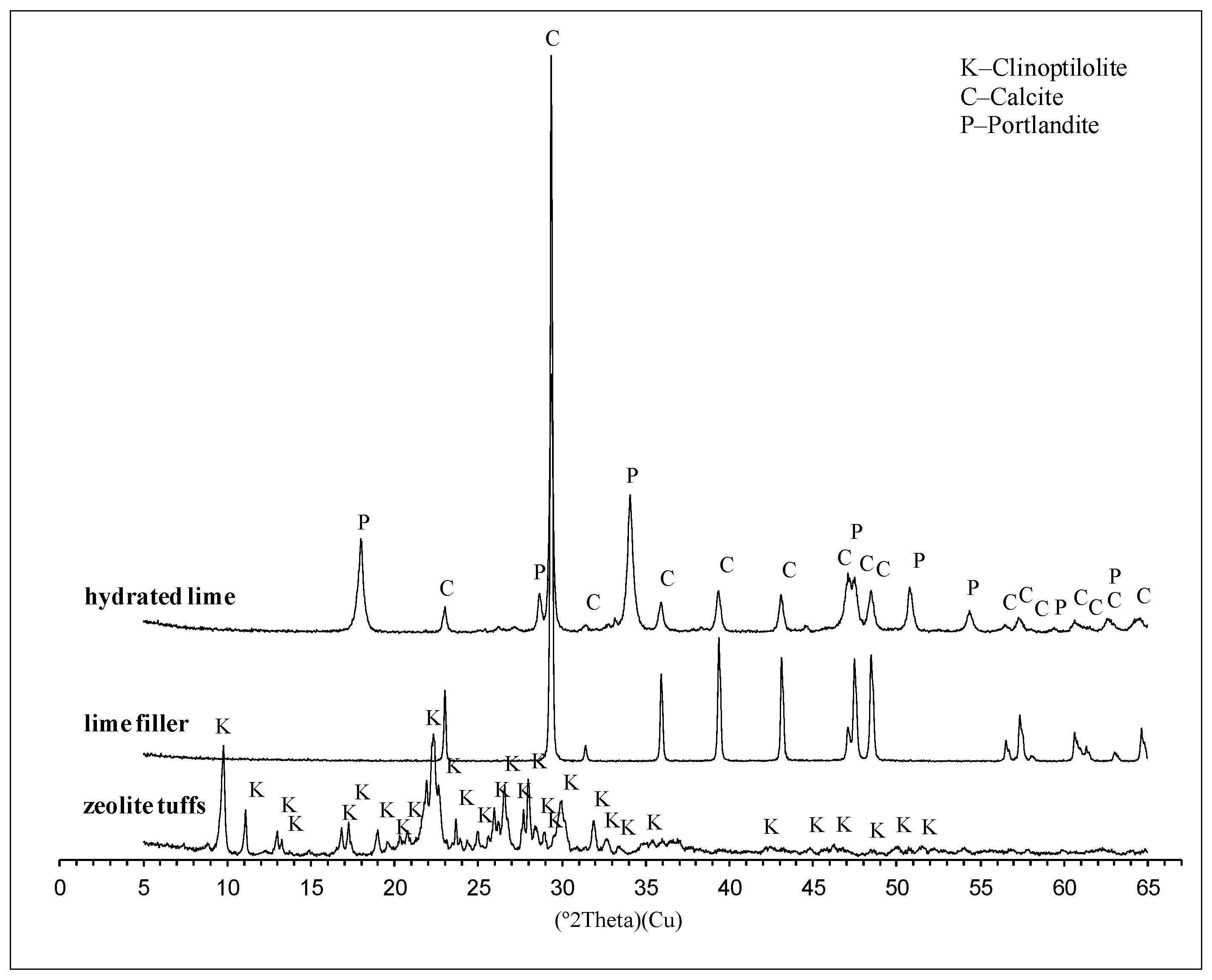

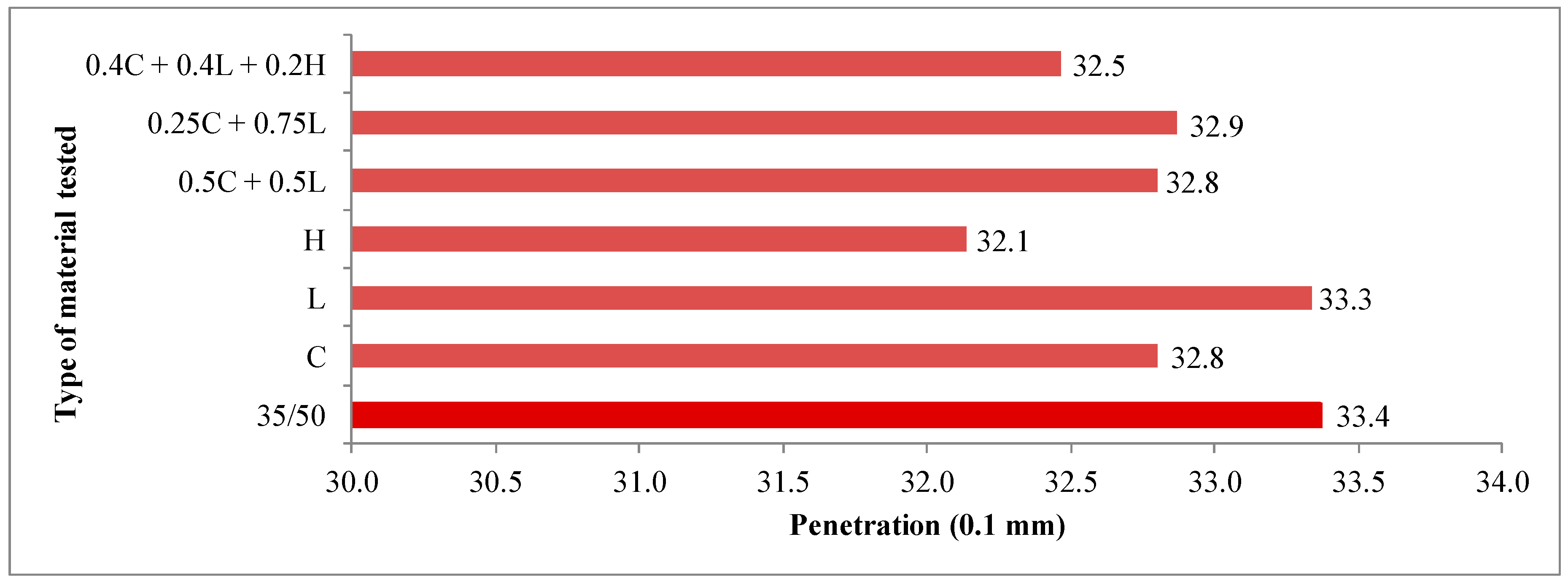
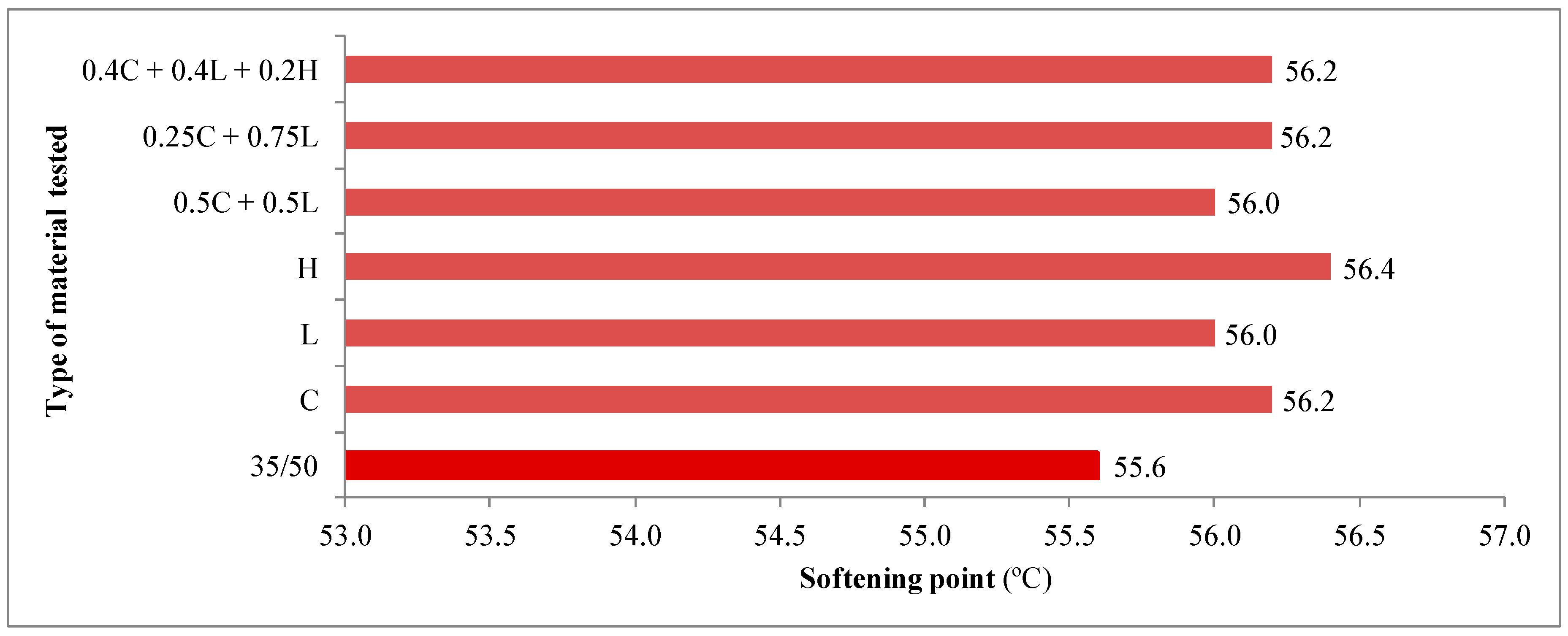
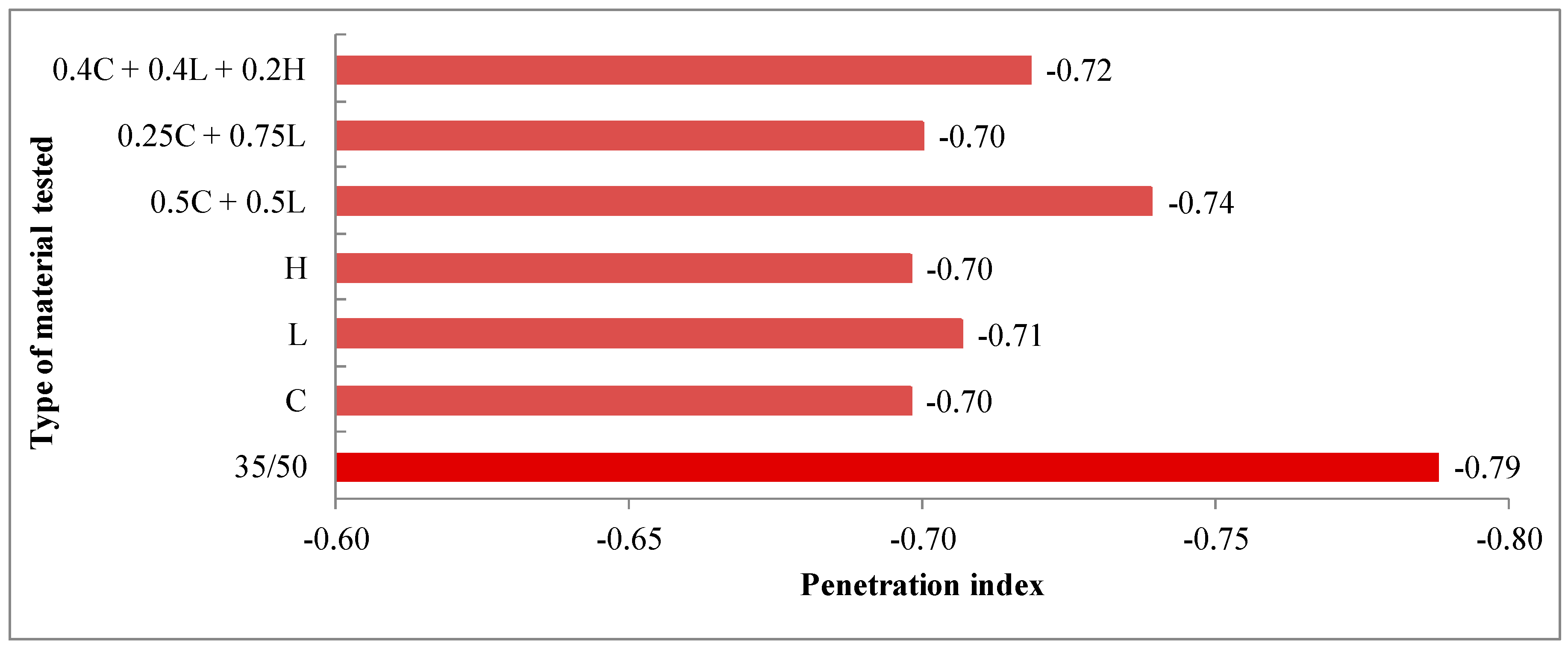
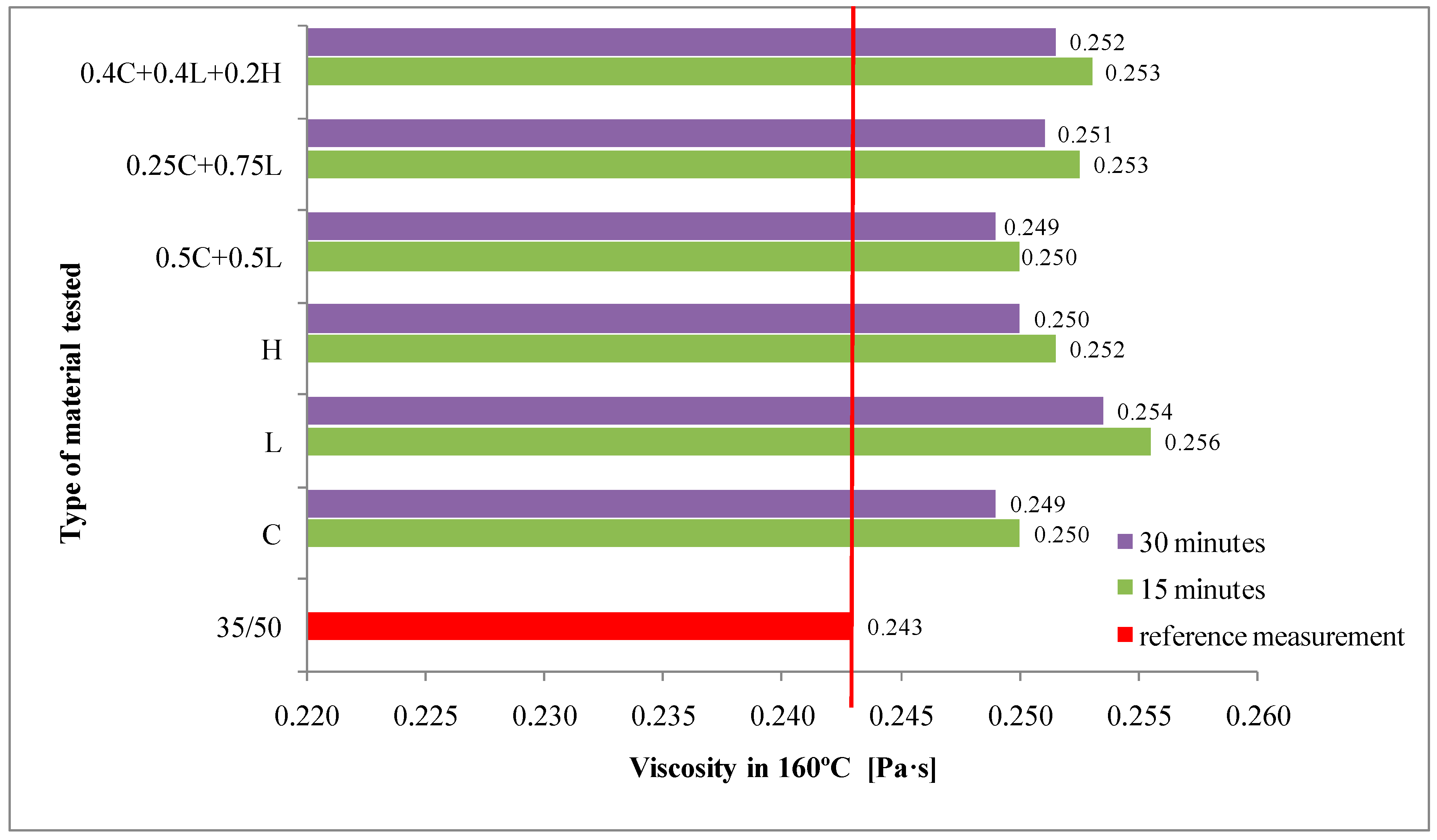
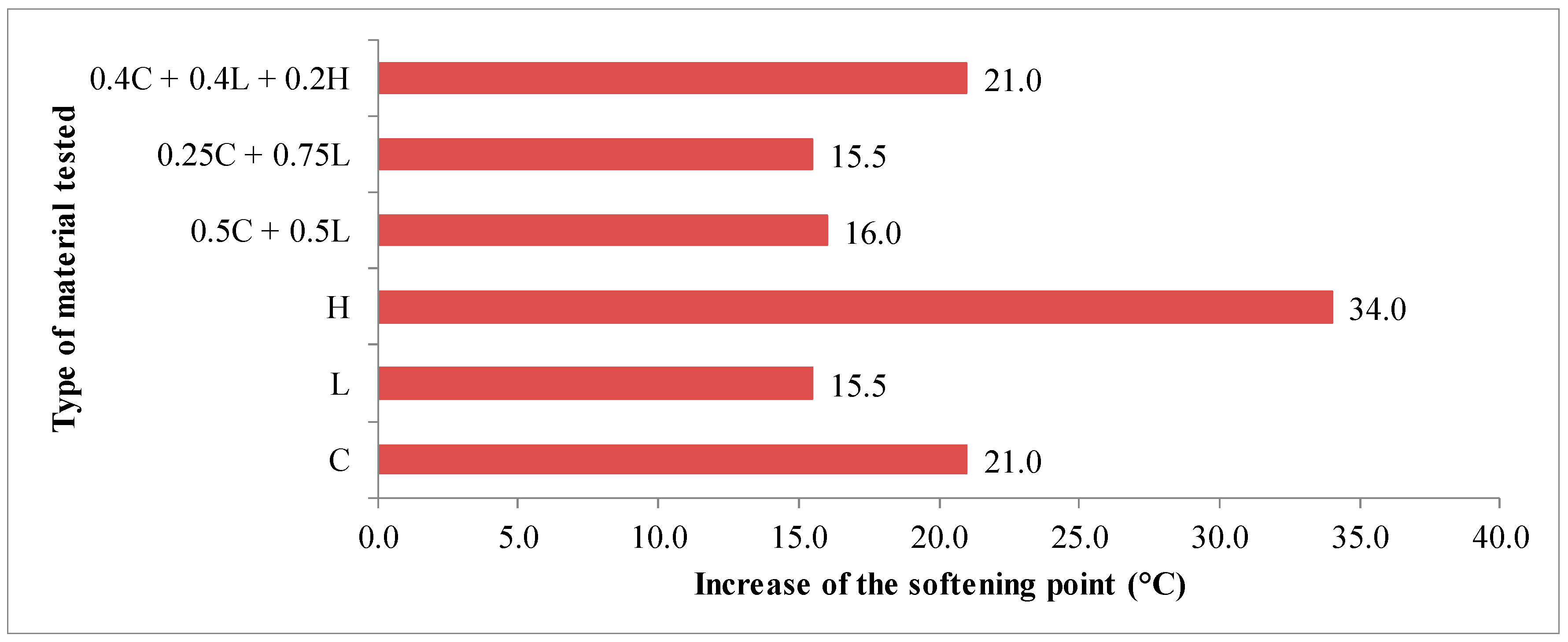
| Test | Specification | Result | ||
|---|---|---|---|---|
| Zeolite Tuff | Limestone | Hydrated Lime | ||
| Particle density (g/cm3) | EN 1097-7:2008 | 2.256 | 2.763 | 2.441 |
| Specific surface area (cm2/g) | EN 196-6:2011 | 10338 | 6783 | 12532 |
| Grading (mm) | EN 933-10:2009 | 0.0–1.0 | 0.0–1.0 | 0.0–0.25 |
| Water content (%) | EN 1097-5:2008 | <1.0 | <1.0 | <1.0 |
| Test | Specification | Result |
|---|---|---|
| Penetration (25 °C, 0.1 mm) | EN 1426:2009 | 33.4 |
| Viscosity at 135 °C (mPa s) | ASTM D 4402 | 748 |
| Viscosity at 160 °C (mPa s) | ASTM D 4402 | 243 |
| Softening point (°C) | EN 1427:2009 | 55.6 |
| Zeolite Tuff | Lime Filler | Hydrated Lime | |
|---|---|---|---|
| (% of weight) | |||
| Na2O | 0.01 | 0.00 | 0.00 |
| MgO | 0.77 | 0.21 | 0.33 |
| Al2O3 | 9.28 | 0.15 | 0.45 |
| SiO2 | 65.92 | 0.27 | 0.90 |
| P2O5 | 0.03 | 0.02 | 0.00 |
| SO3 | 0.01 | 0.04 | 0.40 |
| K2O | 2.79 | 0.00 | 0.09 |
| CaO | 2.95 | 74.68 | 97.16 |
| TiO2 | 0.23 | 0.00 | 0.00 |
| Fe2O3 | 1.69 | 0.06 | 0.62 |
| Test Type | Origin | SS | df | MS | F | p value | Test F |
|---|---|---|---|---|---|---|---|
| Penetration | Intergroups | 3.484762 | 6 | 0.580794 | 2.753198 | 0.055535 | 2.847726 |
| Intragroups | 2.953333 | 14 | 0.210952 | ||||
| Softening point | Intergroups | 0.758571 | 6 | 0.126429 | 0.863415 | 0.563036 | 3.865969 |
| Intragroups | 1.025 | 7 | 0.146429 | ||||
| Dynamic viscosity | Intergroups | 0.000194 | 6 | 3.24E-05 | 12.37576 | 6.75E-05 | 2.847726 |
| Intragroups | 3.67E-05 | 14 | 2.62E-06 |
| Type of Used Filler | p value |
|---|---|
| C | 0.00873 |
| L | 0.00676 |
| H | 0.01243 |
| 0.5C + 0.5L | 0.01015 |
| 0.25C + 0.75L | 0.00743 |
| 0.4C + 0.4L + 0.2H | 0.00304 |
© 2019 by the authors. Licensee MDPI, Basel, Switzerland. This article is an open access article distributed under the terms and conditions of the Creative Commons Attribution (CC BY) license (http://creativecommons.org/licenses/by/4.0/).
Share and Cite
Woszuk, A.; Wróbel, M.; Franus, W. Application of Zeolite Tuffs as Mineral Filler in Warm Mix Asphalt. Materials 2020, 13, 19. https://doi.org/10.3390/ma13010019
Woszuk A, Wróbel M, Franus W. Application of Zeolite Tuffs as Mineral Filler in Warm Mix Asphalt. Materials. 2020; 13(1):19. https://doi.org/10.3390/ma13010019
Chicago/Turabian StyleWoszuk, Agnieszka, Michał Wróbel, and Wojciech Franus. 2020. "Application of Zeolite Tuffs as Mineral Filler in Warm Mix Asphalt" Materials 13, no. 1: 19. https://doi.org/10.3390/ma13010019






